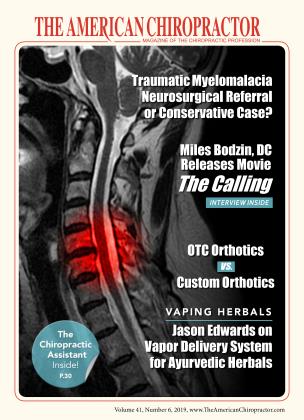The Current State of Chiropractic Software
PRACTICE MANAGEMENT
Dr. Michael L. Silbert
I know that when you graduated from chiropractic college, you never thought, “I can’t wait to start practicing so I can write really great SOAP notes.” Most likely, you dreamed of helping many people get well without drugs or surgery, but you knew then and know now that you need to create adequate documentation or you will eventually get into trouble. The problem with old-fashioned handwritten notes (how you were trained in school) is that they are difficult to read (doctors often have illegible handwriting), take too long to write, and don’t remind you of important issues pertaining to a specific patient (more on that later). Your best option is computer-generated notes because dictation is too expensive and slow.
If you search online or look through trade publications, you will find companies that have created documentation and billing software specifically for chiropractors. As with many decisions, it is often not an apples-to-apples comparison. Different software has different features, some of which you may not need, and probably don’t want to pay for. Most of the companies offer either live and or video demos, which will give you a feel for the ease of using a particular program. Check to make sure that the company offers a money-back guarantee to minimize the risk of being “stuck” with a program you don’t like.
Another factor to consider is whether the software is “on the cloud” or is “on premises” (server-based). Deciding which you want revolves around several factors. If you have more than one office location, and have patients that visit you in different offices, having access to their notes by logging on to a cloud-based server may make sense. Another way is to use remote-access software. My research shows that there is typically a monthly fee for cloud hosting. Some parts of the country do not always have reliable Internet, which may make cloud-based note-taking challenging. I find that if you have one location, a “server-based” system is more than adequate, and if you occasionally want to finish your notes from home, you can use “remote-in” software to see your office computer.
Generally, chiropractors may need to write only six kinds of documents from time to time, which are new patient consultation, orthopedic and neurological exam, X-ray report, treatment plan, daily SOAP note, and narrative report. I also have observed that chiropractors need to be able to customize their notes because no two practice the same way. Some “only” adjust the spine (straights), some love using modalities (mixers), and others incorporate a lot of nutrition or exercise. The system you select needs to allow you to document the way you practice so you don’t get frustrated and stop using it. You should be able to add nutritional supplements and as many exercises as you want.
I want to address the feature I call “reminders” that I referenced earlier. You should be able to have messages pop up that protect you and are not written in the notes, such as, “This patient is pregnant,” “Use an Activator on this patient because he hates having his neck adjusted,” or ’’This patient has osteoporosis and a right prosthetic hip, do not side line, etc.” These alerts will help prevent you from getting in trouble when you are running behind schedule or distracted.
Text randomization is also a helpful feature that prevents you from being accused of SALT-ing your notes (i.e., “same as last treatment,” when notes begin to look the same). With this feature, even if you did the exact treatment two times in a row, the notes will not read the same.
With a little practice, you should be generating your SOAP notes in 15 to 20 seconds, and the treatment should be justified by the objective findings. For example, if you were performing trigger point therapy, it would be a good idea to mention in the objective findings that you found trigger points and where they were. In the same way, if you were teaching a patient to strengthen his or her core musculature, it would be helpful to indicate in the objective portion that the patient had weak abdominal muscles. So if there is an audit, it is obvious to the reviewer that you did what you did, because of what you found.
Perhaps the most important issue is the cost of the software. I have seen two pricing models: subscription and ownership. With subscriptions, you pay a monthly fee, and that adds up over time. With the ownership model, once you have paid for the software, it is yours and the software company may charge a yearly technical support fee, but in the end, the cost is always less.
As I mentioned, to create good documentation, you don’t need to reinvent the wheel. So just do some research, a demo or two, and learn the system. It will be time and money well invested.
Michael Silbert, DC graduated from NUHS in 1993 and has practiced in Chicago ever since. He is the co-founder of E-Z Notes, a Documentation/ Billing software for chiropractors started in 2002. He can be reached at: 312-212-1602
email: drmsilbert@eznotesinc website: www.eznotesinc.com
 View Full Issue
View Full Issue






